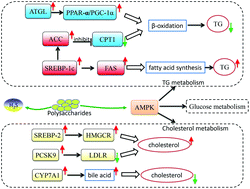Polysaccharides derived from natural sources regulate triglyceride and cholesterol metabolism: a review of the mechanisms
Abstract
With great changes in people's lifestyles, the incidence of hyperlipidaemia has dramatically increased in recent years. Numerous studies have demonstrated that natural polysaccharides have lipid lowering effects. In this review, the causes and mechanisms of hyperlipidaemia are discussed in order to better understand how polysaccharides alleviate hyperlipidaemia. Natural polysaccharides reduce triglyceride levels through ATGL–(PPAR-α)/(PGC-1α), (SREBP-1c)–ACC/FAS and ACC–CPT1 signal pathways, and exert cholesterol lowering effects via (SREBP-2)-HMGCR and bile acid biosynthesis pathways. Activation of adenosine monophosphate-activated protein kinase (AMPK) is the key factor that mediated the simultaneous regulation of both glucose and lipid metabolism by polysaccharides. The new discovery of polysaccharides increasing the production of endogenous H2S, an important physiological gaseous signaling molecule, is also discussed. Collectively, the current available data suggest that natural polysaccharides could be potentially developed as new and safe lipid-lowering drugs; yet further mechanistic and clinical studies are required during this long-term process.



 Please wait while we load your content...
Please wait while we load your content...